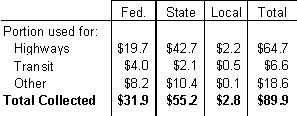U.S. Department of Transportation
Federal Highway Administration
1200 New Jersey Avenue, SE
Washington, DC 20590
202-366-4000
| Conditions and Performance Report Chapter 6—Highway, Bridge and Transit Finance |
| Conditions and Performance Chapter Listing Conditions and Performance Home Page
|
|
| Q Were all revenues generated by motor-fuel taxes, motor vehicle taxes and fees, and tolls in 1997 used for highways? |
A No. As shown in Exhibit 6-3, highway-user revenues—the total revenues generated by motor-fuel taxes, motor-vehicle taxes and tolls—totaled $89.9 billion in 1997. The $64.7 billion identified as highway user charges in Exhibit 6-2 includes only those revenues from these sources that were used for highways. This represents only 71.9 percent of the total highway-user-revenues. In 1997, $6.6 billion (7.3 percent) was used for transit and $18.6 billion (21.8 percent) was used for other purposes, such as ports, schools, deficit reduction, collections costs, and general governmental activities. The $18.6 billion of highway-user-revenues used for purposes other than highway or transit, consists of $10.4 billion of State and local revenue and $8.2 billion of Federal revenue. Note that the Federal amount will be much lower in 1998 and future years. Starting in Fiscal Year 1998, motor-fuel tax revenue that was formerly credited to the general fund for deficit reduction will instead be credited to the HTF. The $6.6 billion of highway-user-revenues used for mass transit includes $2.6 billion of State and local revenue and $4.0 billion of Federal revenue. The Federal amount includes $3.3 billion deposited into the Mass Transit Account of the HTF, and $0.7 billion that was deposited in the Highway Account of the HTF that States elected to use for mass transit purposes. |
| Exhibit 6-3 |
| Disposition of Highway-User Revenue by Level of Government, 1997 (Billions of Dollars) |
 |
| Source: 3/16/99 Highway Funding Bulletin. |
Of the $106.5 billion in total revenues generated for highways in 1997 ($101.3 billion spent in 1997 plus $5.2 billion placed in reserves), 60.8 percent came from highway-user charges, including motor-fuel taxes, motor-vehicle taxes and fees, and tolls. The remaining 39.2 percent originated from a number of sources, including local property taxes and assessments, other dedicated taxes, general funds, bond issues, and miscellaneous sources such as investment income, miscellaneous fees, development fees, and special district assessments. The degree to which highway programs are funded by highway-user charges differs widely between the various levels of government.
At the Federal level, 91.4 percent of highway revenues come from motor-fuel and motor-vehicle taxes. The remainder comes from general fund appropriations, timber sales, lease of Federal lands, oil and mineral royalties, and investment income. Note that on October 1, 1998, interest accrual to the Highway Trust Fund (HTF) ceased.
Highway-user charges also provide the largest share, 75.5 percent, of highway funds at the State level. Bond issue proceeds are another significant source of funding, providing 10.5 percent of highway funds at the State level. The remaining 14.0 percent of State highway funding comes from general fund appropriations, other State taxes and fees, investment income, and other miscellaneous sources.
Many States do not permit local governments to impose motor-fuel and motor-vehicle taxes, or cap them at relatively low levels. Therefore, at the local government level, only 7.9 percent of highway funding is provided by highway-user charges. Local general funds, property taxes, and other taxes and fees are the source of 66.7 percent of local highway funding. Bond issues proceeds provide 11.4 percent of local highway funding, while investment income and miscellaneous receipts provide the remaining 14.0 percent.